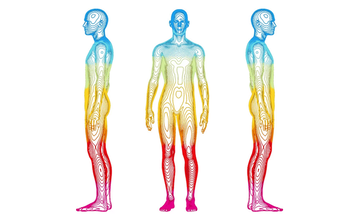
The Body Scan would fall under the umbrella of Mindfulness, which refers to a mental state of nonjudgmental awareness of the present moment. This process encourages openness, curiosity, and acceptance. It may be a strange thing to think about accepting the sensations in our body that we dislike. When a person manages to focus on their internal experience/sensations, there is often a lot of self-critical, negative, and otherwise worrisome thoughts and emotions that most people will try to suppress or avoid. Sometimes just paying attention to a painful area of our body can be so uncomfortable that people will prefer to do nearly anything else.
By changing their perspective on unpleasant thoughts, feelings, or sensations, people can come to realize that what they are experiencing is not as dangerous or powerful as they first feared, and that this cycle can weaken over time. Through practice, people can attempt to see themselves as separate from their distressing thoughts, feelings, and sensations.
The body scan could be considered to be a part of an area of research called Mindfulness-Based Interventions, where we try to pay more attention to the experiences of the moment to better evaluate them and see if we can intervene in the process on an internal level. These interventions have repeatedly been found to help reduce chronic pain symptoms (including fibromyalgia, migraine, chronic pelvic pain, irritable bowel syndrome, and other conditions). In patients, training in mindfulness improves self-reports of anxiety, depression, stress, and cognition (thinking/concentration). It is important to note that in these cases, the reports of pain were not necessarily decreased, but the unpleasantness and negative effect of that pain had decreased, allowing people to participate in more aspects of their daily lives.
The specific pain relieving mechanisms have yet to be determined, but the improvement in body awareness and nervous system regulation appear to have an overall positive effect. People who practice this attention to their own body and sensations demonstrate decreased brain activation in areas that process pain and connect emotions to their experience. People are taught to notice what they are feeling and then to allow the feeling to pass as able.
Let’s go through what a body scan can look like, as depicted in the book written by Todd Hargrove, referenced below.
Purpose - to assist with the mapping of the body in the brain and develop the skill of focusing and reorienting attention in the body. This is a useful tool for reducing stress and pain on its own as well as part of a more comprehensive program. Each part of the body can be done independently, in part, or in a whole body scan depending on time available and needs of the individual.
This can be performed in sitting, lying, or any position where you can feel at ease.
Begin by noticing the parts of the body that are contacting the floor, chair, or surface that you are interacting with. How much pressure is being applied to the surface? Is it even and symmetrical?
Feet - Which way do they point, do they point equally on either side, is the pressure the same? You can seek to equalize the pressure or just note the differences and move on.
Legs - Are both legs experiencing the same amount of bend, or lack of bend? Does one leg feel longer or shorter than the other? Try moving them gently back and forth or not the differences and move on.
Pelvis/Hips - Where in the hips and/or pelvis do you feel the most pressure? How does this change the sensation down each of the legs. Could you make the pressure more even by adjusting the body? Feel free to move the hips and pelvis to achieve a more centered position or just note the sensations/differences and move on.
Spine - Try to follow the line of your spine from bottom to top, starting at the tailbone and going one piece at a time to the base of the skull. Try to imagine each of the bones that make up your spine and see if there are any areas that are harder to “see”. Can you change your posture or the length of your body position to make these areas clearer in your mind? Try to move in a way that makes it more comfortable, or simply note the sensations and move on.
Shoulders - Are the shoulders resting evenly? Are they elevated or forward? Could they be more relaxed? Try to bring the shoulders into a position where they are holding no weight, or just note the sensations on either side and move on.
Arms - Trace down the length of your arm and see if there is any tension in the arms or hands even at rest. Can you feel where the wrist and hand begins compared to the forearm? Wiggle and move anything that is having trouble letting go, or simply make a note of what you feel and move on.
Head - Try to feel which direction your nose is pointing. Is it in the middle, or does it favour one side? Is the jaw fully relaxed? What are the muscles in the face and forehead doing right now? See if you can unclench anything that remains tight, or simply make a note of the sensations and move on.
Breathing - As you go through the body scan consider the breath. Where do you feel the majority of the movements when you inhale and exhale? Can you change where the movement comes from? Into the belly, the chest, or outward into the ribs? Make a note of what feels the most natural and move on.
Try this throughout the day as your schedule allows. You may be pleasantly surprised with what can be accomplished by getting back in tune with your own body on a regular basis.
As always, please feel free to contact the office with any questions you may have.
~ Trent, PT
References
- Mindfulness meditation-based pain relief: a mechanistic account. Zeidan, F and Vago, D. Ann N Y Acad Sci. June 2016.
- Mindulness-Based Interventions for Anxiety and Depression. Hofmann, S., and Gomez, A. Psychiatr Clin North Am. December 2017.
- A Guide to Better Movement: The Science and Practice of Moving with More Skill and Less Pain. Hargrove, T. 2014.

 RSS Feed
RSS Feed